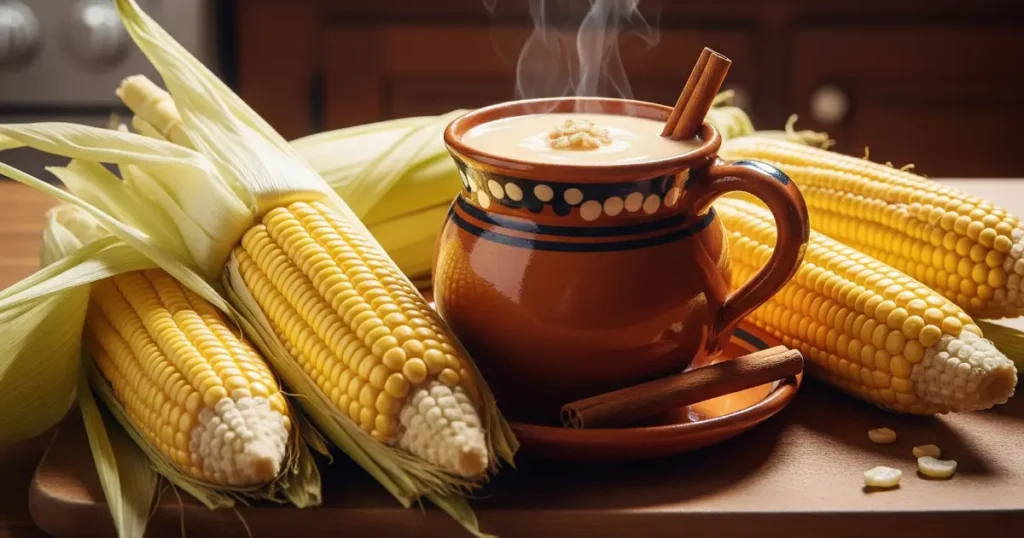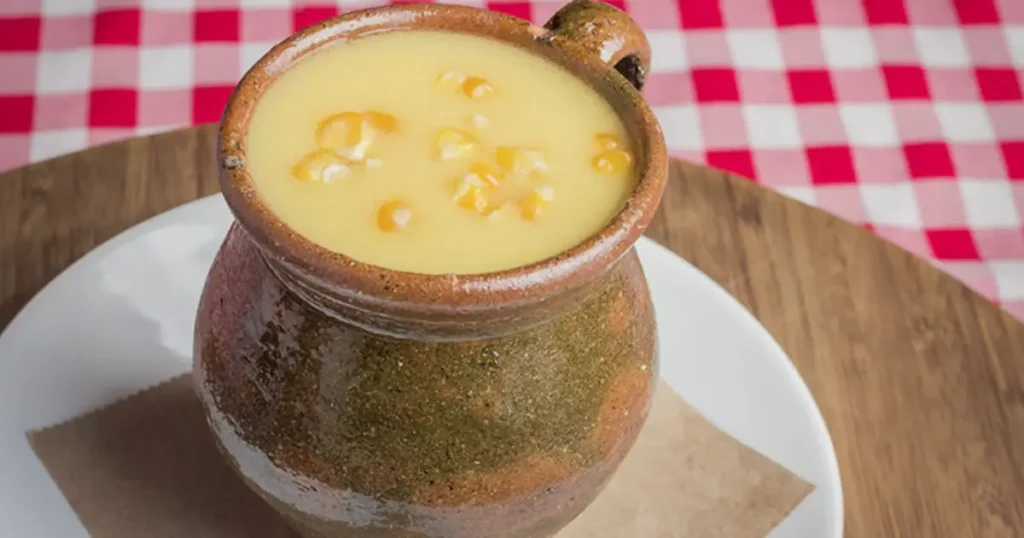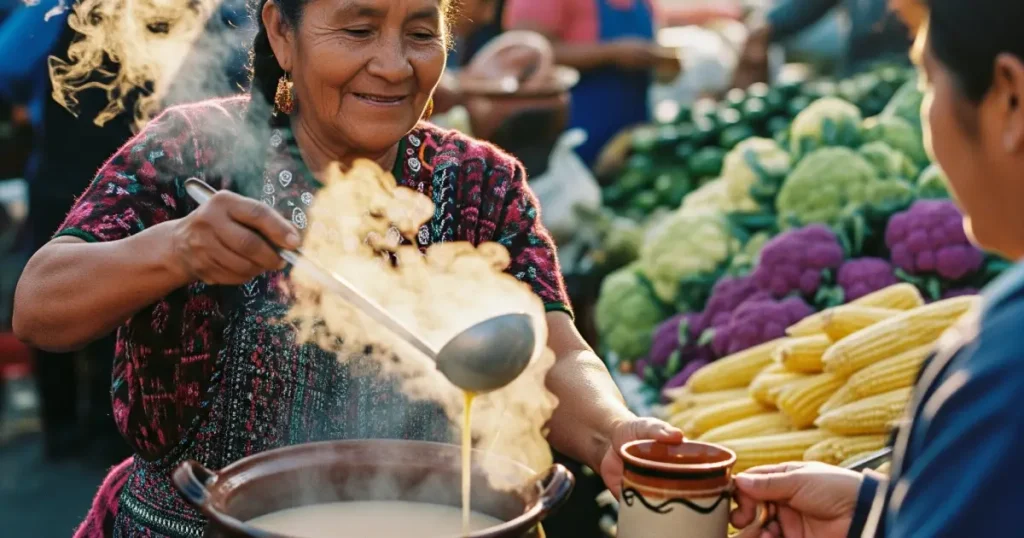In the heart of Mesoamerica, where corn is not just a crop but a sacred cultural cornerstone, Guatemala boasts a rich tapestry of culinary traditions. Among its most beloved and comforting beverages is Atol de Elote, a warm, sweet, and creamy concoction made from fresh corn.
This golden elixir, often scented with cinnamon, is more than just a drink; it’s a taste of home, a symbol of agricultural bounty, and a cherished ritual enjoyed by Guatemalans of all ages, particularly when the highland air turns cool.
What Exactly is Atol de Elote? The Essence of Corn in a Cup

Atol de Elote, at its core, is a traditional Mesoamerican beverage whose primary ingredient is fresh corn (elote). The word atol (or atole in some regions) itself has Nahuatl origins, deriving from ātōlli, and generally refers to a variety of thick, warm drinks made from masa (corn dough) or, in this case, fresh corn kernels.
Guatemalan Atol de Elote is specifically prized for its use of sweet, tender corn, which imparts a natural sweetness and a vibrant, fresh flavor that distinguishes it from atoles made with dried corn masa.
Typically, the fresh corn kernels are ground or blended, then simmered with milk or water (or a combination of both), sweetened with sugar or panela (unrefined whole cane sugar), and delicately spiced, most commonly with cinnamon.
The result is a beverage with a smooth, velvety texture, ranging from slightly thickened to a more porridge-like consistency, depending on preference and regional variations. It’s a comforting, nourishing, and deeply satisfying drink that embodies the essence of Guatemalan culinary heritage.
A Taste of History: The Ancient Roots of Atol
The story of Atol de Elote is intrinsically linked to the profound history of corn in Mesoamerica. Corn, or “maíz,” was first domesticated in this region thousands of years ago and quickly became the foundation of civilizations like the Maya, whose heartland encompasses present-day Guatemala. For the Maya, corn was not merely sustenance; it was a sacred gift from the gods, central to their cosmology, mythology, and daily life. The Popol Vuh, the sacred Mayan creation myth, even tells of humans being created from corn.
Given this deep reverence for corn, it’s no surprise that various forms of atol have been consumed in the region for centuries. Archaeological evidence and ancient texts suggest that atoles were a staple for the Maya and other Mesoamerican cultures, enjoyed by commoners and royalty alike. These early versions were likely simpler, possibly consisting of ground corn and water, perhaps flavored with local spices or sweeteners like honey if available.
With the arrival of the Spanish in the 16th century, new ingredients were introduced, which gradually influenced local cuisines. Dairy milk, cane sugar, and spices like cinnamon found their way into traditional recipes, leading to the evolution of Atol de Elote as it is widely known and loved today. Despite these additions, the soul of the beverage remains firmly rooted in its indigenous origins and the timeless importance of corn.
The Art of Preparation: Crafting the Perfect Cup of Guatemalan Atol de Elote
Making Atol de Elote is an art form passed down through generations, with many families having their own cherished recipes and subtle variations. While recipes can differ, the fundamental steps and core ingredients remain largely consistent.

Key Ingredients:
- Fresh Corn (Elote): This is the star ingredient. Yellow sweet corn is most commonly used for its flavor and vibrant color, though white corn can also be utilized. The fresher the corn, the better the atol. In Guatemala, vendors often use corn freshly picked from the cob.
- Liquid: Whole milk is a popular choice for a richer, creamier texture. However, some recipes call for water, evaporated milk, or a blend, catering to different tastes and dietary preferences.
- Sweetener: Granulated sugar is widely used. Panela (rapadura or piloncillo in other regions) adds a distinct molasses-like depth of flavor that many Guatemalans prefer. The level of sweetness is always adjusted to personal taste.
- Spice: Cinnamon sticks are the traditional spice of choice, infusing the atol with a warm, comforting aroma and flavor. Ground cinnamon can also be used, often sprinkled on top before serving. Some recipes might include a hint of vanilla.
- Salt: A pinch of salt is crucial. It doesn’t make the atol salty but rather enhances the sweetness and overall flavor profile of the corn.
- Optional Thickener: While the blended corn itself provides thickness, some recipes, particularly those aiming for a very dense consistency or when using less starchy corn, might incorporate a small amount of cornstarch (maicena) dissolved in a little cold water or milk.
The Traditional Process:

- Preparing the Corn: The fresh corn kernels are cut from the cob. Traditionally, this corn would then be ground on a “piedra de moler” (grinding stone or metate), a laborious process that extracts the milky pulp and fine corn solids. Today, a blender is the more common and convenient tool. The kernels are blended with a portion of the liquid (milk or water) until a smooth, homogenous mixture is achieved.
- Straining (Optional but Common): To achieve an extra-smooth, velvety texture, the blended corn mixture is often strained through a fine-mesh sieve or cheesecloth. This removes some of the coarser corn pulp and fibers. However, some prefer a more rustic atol with all the corn solids included for added texture and fiber.
- Simmering and Flavoring: The strained (or unstrained) corn liquid is then transferred to a pot. The remaining liquid, cinnamon stick(s), sugar (or panela), and a pinch of salt are added.
- Constant Stirring: This is perhaps the most critical stage. The mixture is cooked over medium-low heat and must be stirred constantly, especially as it begins to heat up and thicken. Constant stirring prevents the atol from sticking to the bottom of the pot, scorching, or forming lumps. It also helps to prevent the milk from curdling. Guatemalan grandmothers often advise stirring in one direction.
- Thickening to Perfection: The atol is simmered until it reaches the desired consistency. This can take anywhere from 15 to 30 minutes, or even longer, depending on the quantity and desired thickness. It should be thick enough to coat the back of a spoon but still pourable.
- Serving: Once ready, the Atol de Elote is served hot. It’s often poured into mugs or traditional “jarritos” (clay cups). A sprinkle of ground cinnamon or a few reserved whole corn kernels are common garnishes.
Cultural Significance: More Than Just a Beverage
In Guatemala, Atol de Elote is far more than a simple drink; it’s deeply embedded in the cultural fabric and daily life of the nation.

- A Comforting Ritual: For many Guatemalans, Atol de Elote evokes feelings of warmth, comfort, and nostalgia. It’s a go-to beverage during the cooler months or on rainy afternoons, offering a soothing respite. It’s often enjoyed in the morning for breakfast or in the late afternoon as a “refacción” (snack).
- Street Food Staple: Atol de Elote is a ubiquitous street food, especially in highland towns and cities like Antigua Guatemala, Quetzaltenango (Xela), and Guatemala City. Vendors, often women, can be seen ladling the steaming, fragrant beverage from large pots into cups for eager customers, particularly in the early mornings and evenings. These street-side stalls are often bustling hubs of community.
- Celebrations and Gatherings: While an everyday drink, Atol de Elote also features in festive occasions, family gatherings, and religious celebrations. Its nourishing qualities and crowd-pleasing flavor make it a welcome addition to any communal event.
- Symbol of Agricultural Identity: As a corn-based beverage, Atol de Elote is a direct reflection of Guatemala’s agricultural identity and its deep connection to maíz. It celebrates the bounty of the harvest and the ingenuity of transforming a simple staple into a delicious and beloved drink.
- Economic Importance for Local Vendors: The preparation and sale of Atol de Elote provide a livelihood for many individuals and families, particularly women, in both urban and rural areas. It represents a form of small-scale entrepreneurship rooted in culinary tradition.
Regional Variations and Modern Twists
While the classic Atol de Elote recipe is widely recognized, slight variations can be found across different regions of Guatemala and even from family to family.
- Atol de Elote Shuko (Sour Corn Atol): Primarily found in the department of Petén, this version involves fermenting the corn slightly before preparing the atol, giving it a unique tangy or “shuko” (sour) flavor. This is a distinct taste profile compared to the sweet atol popular in most other parts of the country.
- Thickness and Sweetness: The consistency can vary from a thinner, more drinkable beverage to a very thick, spoonable porridge. Similarly, the level of sweetness is highly subjective.
- Choice of Corn: While yellow sweet corn is preferred for its color and sweetness, some communities might use local varieties of white corn, which can result in a paler atol with a slightly different flavor nuance.
- Added Flavors: Though cinnamon is standard, some modern interpretations might experiment with adding a splash of vanilla extract, a hint of nutmeg, or even a touch of orange zest for a different aromatic profile. One YouTube creator mentioned her grandmother adding orange leaves.
- Atol de Elote with Canned Corn: While fresh corn is traditional and provides the best flavor, recipes using canned corn have emerged for convenience, especially outside of Guatemala or when fresh corn is out of season. These recipes often require adjustments to achieve the desired texture and sweetness.
The Enduring Appeal of Guatemala’s Golden Drink
Atol de Elote is a timeless classic, a beverage that has nourished and delighted Guatemalans for generations. Its appeal lies in its simplicity, its comforting warmth, and its direct connection to the land and its most sacred crop. The aroma of simmering corn and cinnamon evokes a sense of home, tradition, and community.
Whether sipped from a steaming cup on a chilly highland morning, enjoyed as a satisfying afternoon snack from a street vendor, or lovingly prepared in a family kitchen, Atol de Elote offers a delicious glimpse into the heart of Guatemalan culture. It’s a golden elixir that not only tantalizes the taste buds but also warms the soul, a true treasure of Guatemala Food. Its enduring popularity is a testament to the simple yet profound culinary heritage that continues to thrive in this vibrant Central American nation.
